Before you can begin to diagnose vehicle electrical problems, you must first have an understanding of electrical fundamentals. Electrical principles, like voltage, amperage and resistance, can be described as cars passing along the roadway. Voltage would be the vehicles speed, amperage would be the number of vehicles on the road at the same time, and resistance would be the potholes in the roads surface.
 In this article, well go over some of the fundamentals of vehicle electrical systems, and then answer some questions you may ask yourself when working on an electrical diagnostic dilemma. Many technicians in the industry will tell you that in order to succeed in servicing and diagnosing problems in vehicles, you had better have a firm grasp of electrical properties.
In this article, well go over some of the fundamentals of vehicle electrical systems, and then answer some questions you may ask yourself when working on an electrical diagnostic dilemma. Many technicians in the industry will tell you that in order to succeed in servicing and diagnosing problems in vehicles, you had better have a firm grasp of electrical properties.
Basically, electricity is a supply of atoms with an excess number of electrons. The flow of electricity would then be the actual exchange of electrons from atom to atom (see Figure 1) Keeping with the cars-on-the-roadway analogy, well also discuss diodes, DC and AC current, and define the term short circuit in this article.
Diodes are one-way traffic cops. They only allow the electrons to flow in one direction, similar to a one way sign on the streets; they are the check valve in an electrical circuit. The two ends of a diode are called an anode (+) and a cathode (-). The cathode end of the diode has an extra amount of electrons stored in its materials. The anode has a shortage of electrons. Electrically, the anode has holes that happily accept those extra electrons from the cathode side. The light bulb is glowing because at the junction between the anode and cathode, the holes and the electrons meet. The electrons then fill in the holes, lower the diodes resistance, and current then flows through the circuit.
 AC/DC
AC/DC
The terms direct current (DC) and alternating current (AC) refer to the manner in which the electricity flows within the conductor. In DC, the electrons all flow the same direction. Much the same as vehicles all traveling down a single lane of traffic, all of them moving in the same direction. AC, however, will require a little more imagination to picture. The electrons dont flow so much as they vibrate. They move in one direction, then change direction moving completely the opposite way, then back again. This would be one area where my illustration of cars traveling on the road is weak when explaining electricity. After all, its not every day you see people repeatedly slamming their cars in drive and reverse.
 A short circuit resembles a driver cutting across a parking lot to avoid a traffic light. Just as that would be a wrong course of action for a driver, it is also an unwanted path of electrical flow in a circuit (see Figures 2 and 3).
A short circuit resembles a driver cutting across a parking lot to avoid a traffic light. Just as that would be a wrong course of action for a driver, it is also an unwanted path of electrical flow in a circuit (see Figures 2 and 3).
The biggest problem with a short circuit is that the unwanted flow path often has little to no resistance to provide any flow regulation. The electrons will prefer the path with the lower resistance. They will overcrowd (so to speak) the wiring and cause it to melt, possibly resulting in a fire.
The fuse (sometimes a breaker or a fuse link) is the emergency kill switch. The fuse melts to stop the flow before it melts the wiring. Fuses are in place for emergency reasons. They only blow if the amperage has reached an emergency level. They do not get hot under normal conditions, therefore they do not blow under normal conditions with age like a light bulb. When they blow, they create an open circuit where no current flows at all (compare Figures 2 and 3).
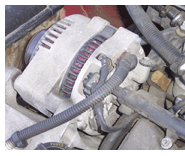 Powering Up
Powering Up
The purpose of an alternator is to supply the power needed for all electrical items on the vehicle, plus replenish the battery fully from the last start up. If the battery doesnt get fully replenished, it will remain in a state of discharge. It will sulfate and become inactive prematurely. Keep in mind though, that the alternator is not a battery charger so much as it is a battery maintainer.
An alternator that has to recharge a battery that is overly discharged can be over-worked, which will shorten its life. This is largely due to the high amount of heat produced by the alternator during its charging process. The greater the amperage flowing through it, the higher the heat. So, anytime an alternator is replaced, the battery should be fully recharged with a battery charger or replaced. Inside the alternator are two strong electromagnets. One is called a rotor. The rotor spins inside of another electromagnet called a stator. As the poles of these magnetic fields collide, an electrical current is induced into the stator.
The voltage induction grows stronger as the poles approach each other. In contrast, when the poles leave each other, the voltage induction steadily reduces as the poles get further and further apart. In reality, there are three magnetic fields in the stator spaced 120 degrees apart. They are produced by three separate windings in the stator, producing three times the number of waves shown in the figures. Its like three separate alternators inside one housing.
The current induced into the stator is AC current. This is because the voltage induced into the stator changes polarity every 180 revolutions within each magnetic field due to the polar relationships between the stator and rotor being inverted. The current induced into the stator is obviously of no use to the automotive electrical system at this point. Before the current leaves the alternator, it must pass through the diodes.
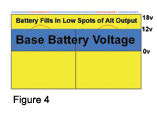 The diodes form what is called a full wave rectifier. A full wave rectifier allows the positive polarity of current to pass and inverts the negative polarity current into what is desired. The voltage has to build up to the desired 12 Vdc to 14.5 Vdc range. Since the automotive electronics are all presently designed to run in that range, much of the alternators output is both useless and jeopardizing to the rest of those components. This is where the battery plays a very important part. As illustrated in Figure 4, any voltage below the batterys own base voltage is canceled out. Filling in the low places and absorbing the excessively high places in the alternators output is how the battery silences the electrical noise in the system.
The diodes form what is called a full wave rectifier. A full wave rectifier allows the positive polarity of current to pass and inverts the negative polarity current into what is desired. The voltage has to build up to the desired 12 Vdc to 14.5 Vdc range. Since the automotive electronics are all presently designed to run in that range, much of the alternators output is both useless and jeopardizing to the rest of those components. This is where the battery plays a very important part. As illustrated in Figure 4, any voltage below the batterys own base voltage is canceled out. Filling in the low places and absorbing the excessively high places in the alternators output is how the battery silences the electrical noise in the system.
Diagnostic Tips
The automotive charging system is one system that is very much the same between makes, yet at the same time, so very different. For some, its normal to see as high as 16 volts for long periods at a time. For others, its normal to see as low as 13 volts. For some, a constant 13.6 volts is an indication of a problem. Still yet for others, its perfectly normal to see the alternator not charge at all intermittently. Some alternators are controlled only with an internal or external regulator. Some are controlled only by the PCM. Still others are controlled by a voltage regulator and the PCM. Not knowing what controls what, and how it is supposed to function, can not only cause a misdiagnosis when there is a problem, it also can cause a critical problem to be overlooked.
A voltage test of the charging system is probably the most popular first test to make. This is backed by a good reason. As with any electrical device, the most popular failure is simply to not function at all. So, if an alternator has quit functioning entirely, then only battery voltage (approximately 12 volts or less) will be seen at the battery.
However, if only battery voltage is present at the battery on a running engine, does this mean the alternator is bad? No, it does not. That only means that the alternator is not charging. That test doesnt reveal why its not charging. Therefore, it doesnt prove a faulty alternator. All too often the alternator is condemned by technicians under this test alone. At this point, a technician should ask him/herself a few questions:
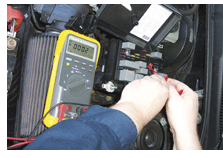 Does the alternator have power to turn on the rotor and stator?
Does the alternator have power to turn on the rotor and stator?
After consulting a wiring diagram, test the light gauge wires at the back of the alternator for battery power. If there is none, this might be due to a broken wire, a connector in the harness undone, faulty ignition switch or even a blown fuse that was caused by a shorted component not even in the charging system.
To condense the fuse panels, engineers will make many unrelated circuits share the same fuse. For example, on a 1999 Dodge Intrepid 3.5L, the alternators stator is fused in the underhood power distribution center by fuse T (20-amp fuse). However, the alternator is not alone on that circuit. Inside the power distribution center is a joint connector that links all four oxygen sensor heaters, the EGR valve and the short runner control valve to that fuse as well. Should a short develop in any one of those circuits, the alternator will fail to charge due to fuse T being blown. Whats more, if the driving conditions are just right before the vehicle comes into the shop, there may not even be a Check Engine light to accompany that battery light. Without proper testing, that alternator may be replaced to no avail.
Is the charging lead between the alternator and battery intact?
It is entirely possible that the alternator may be charging without that voltage making it to the battery. After testing for charging voltage at the battery, and not finding any, the test should be repeated at the point where the charging lead meets the alternator. If charging voltage is present there, the charge lead is open somewhere. That might be due to a blown high amperage fuse (some vehicles have them and some dont) or possibly a severely corroded cable.
If only battery voltage is present, you have not only proven that the alternator is not charging, but also that the charge lead is at least connected from the alternator to the battery.
Is the alternator supposed to be charging at the time you are testing?
Believe it or not, some vehicles dont leave the alternator charging at all times. Some, actually turn the alternator off when not needed. This is nothing new. Honda did this back in the 1980s on the HF (High Fuel) vehicles. To help cheat a few extra miles per gallon, they added a module located near the brake pedal that monitored system voltage. It turned off the alternator when it wasnt needed. Today, some vehicles still employ that tactic, but they use the PCM to control that feature. However, just because the PCM controls the alternator, doesnt mean that its PCM is programmed to completely turn off the alternator.
So you need to be familiar the operating strategies for your charging system. In order to be able to identify it as being bad, you first must know that is good. You must know system description and operation.
OK, what if you do have charging system voltage present at the battery? Is the alternator proven to be good?
No, all you have proven at this point is that the alternator is, at least, turning on. The electricity might be flowing with enough force (voltage), but that doesnt mean anything if the volume (amperage) is not there.
The next logical test is to check the alternators peak amperage output. There are many different amperage ratings of alternators. So, the first thing to do is find out what the peak amperage rating is for the one you are testing. This information is often stamped on the side or back of the alternator. However, it may not be viewable with the alternator installed in the vehicle.
Is the alternator capable of charging at its maximum rating?
First raise the engine rpm to 2,000 and hold it there for the duration of the testing. Then, with a capable load tester connected to the battery cables, and an ammeter clamped over the charging lead, the technician must now place a load on the system.
Watch the system voltage on the load tester while increasing the load. When the system voltage lowers to 12 volts (battery voltage), measure and record the amperage. Immediately remove the electrical load from the system. Compare the measured amperage against the rated amperage. It is perfectly OK for the amperage to be higher than the maximum specs. However, it should not fall short of the rating by more than 10%. For example, it is OK for a 100-amp alternator to peak at 130 amps, but it should not peak at less than 90 amps.
If the peak amperage is too low, does that mean the alternator is bad?
A weak charging alternator can be the result of a slipping belt (they dont always squeal), a slipping pulley on a degraded harmonic balancer, or high resistance in the wiring (either the charge lead to the battery or the stator and rotor primary power supply).
After inspecting the belt drive components, a voltage drop test must be performed to determine the health of the wiring. To voltage drop test the positive cable, place the negative lead of a voltmeter on the positive battery terminal (not the cable, so as to include the clamp to terminal connection). Then place the positive lead of the voltmeter at the cable to alternator output junction on the alternator. Have a coworker help you raise the engine rpm to 2,000 and load the electrical system to the alternators peak output. Measure the voltage showing on the voltmeter. Preferably, this reading should be very low, no more than 2 volts.
The electricity should prefer to travel through the cable since the resistance of the cable is so much lower than the resistance inside the voltmeter. Repeat that same test for the negative side by testing from the alternator case to the negative battery terminal. The negative side should be less than 1.5 volts. As for the stator and rotor primary feed, you will have to consult a wiring diagram and service manual to determine what to measure. Some may require 12 volts only, some require a duty cycling ground back to the PCM, some might have a 5-volt duty cycle feed coming from the PCM.
Is there anything else?
Yes. Usually faulty diodes would have shown up as a weak alternator during the peak amps test, but not always. Most battery testers will automatically say the diode is good or bad, or some have a ripple meter on them to simplify this check. This check can also be performed with an oscilloscope. If the diodes are faulty, they will pass AC current into the vehicles electrical system creating a ripple effect on top of the DC voltage. The idea is to measure this ripple effect. Keep in mind however that some ripple effect is normal, and it is the duty of the battery to dampen the ripple. A failing reading can be the result of a faulty battery. So, if you see the tester is showing that the diode is bad, repeat the test with either a new battery installed, or with an emergency jump-start pack clamped to the battery cables before rendering the final verdict.
Also, another thing that should be checked is a scan of the PCM on vehicles where the PCM controls the alternator. Scanning for codes and observing alternator command PIDs are very important in proper diagnostics of those systems. For example, upper 1990s-and-later Windstar vans used a voltage regulator inside the alternator that was controlled by the PCM.
If communications were lost between the PCM and alternator, the PCM would turn on the battery light, but the regulator would still charge the alternator at about 13.6 volts. The PCM would set a trouble code relating to that loss of communication. Imagine trying to diagnose a battery light that doesnt appear to have any reason to be on. That is, it doesnt appear to have a valid reason until a scanner is added to the testing.
A Case Study
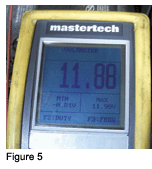 As a quick case study, Id like to point out this 1996 Explorer with a lack of charging condition. Voltage present at the battery was nothing more than charging system voltage (see Figure 5). The next step was to measure the voltage between the positive terminal at the back of the alternator and ground.
As a quick case study, Id like to point out this 1996 Explorer with a lack of charging condition. Voltage present at the battery was nothing more than charging system voltage (see Figure 5). The next step was to measure the voltage between the positive terminal at the back of the alternator and ground.
The voltage was extremely high (see Figure 6). The voltage regulator was full fielding the alternator. Normally this kind of voltage would be a problem. However, if youll remember, none of those volts are getting to the vehicles electrical system. So these high volts, in this case, actually prove the alternator and voltage regulator to be working.
So why arent the volts getting to the battery?
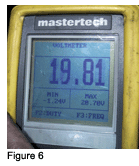 A voltage-drop test should be performed between the positive battery terminal and the alternators positive terminal. Again we see a voltage reading like in Figure 6. So there we have it, high resistance in the charging lead to the battery. A quick look at the fuse links at the fender mount starter relay shows the problem.
A voltage-drop test should be performed between the positive battery terminal and the alternators positive terminal. Again we see a voltage reading like in Figure 6. So there we have it, high resistance in the charging lead to the battery. A quick look at the fuse links at the fender mount starter relay shows the problem.
The fuse link wasnt mounted to the relay. There were burn marks on the treads of the lug for the relay. It would appear that the fuse link spent some time loose on that terminal and fell off later. After reinstalling that fuse link in the proper place, that charging voltage is now in a normal range. The battery was then recharged and tested. The battery passed the load test. The charging system voltage after the battery recharge rose up to 14.5 volts DC. Without proper testing, that alternator could have been easily misdiagnosed.
Lesson learned!


